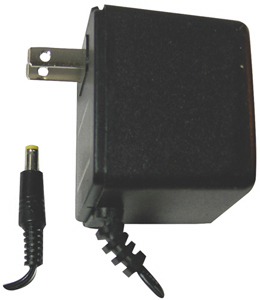AC adaptor
From Sega Retro
Consoles by Sega, and many other electrical devices require power, and this need is commonly addressed by an AC adaptor.
Most modern homes are linked to a power grid, and offer power from electrical sockets. An AC adaptor takes some of that power and gives it to an electrical device, e.g. a Sega Mega Drive. Electrical standards vary between countries but a Sega Mega Drive typically requires only a certain amount regardless of origin, thus one role of the AC adaptor is to only allow a certain amount of power through.
It is called an AC adaptor as it converts alternating current (AC) into direct current (DC). Alternating current is used to help electrical impluses travel long distances but is useless in electrical equipment and thus needs converting. Also when travelling large distances voltages (measured in volts, V) are kept high while currents (measured in amps, A) are kept low - this is also not appropriate for home use. Though the science behind AC adaptors can be confusing for those not familiar with the laws of physics, the the short description is that an AC adaptor gives a console life without destroying the internal components.
AC adaptors are a necessary evil - they are often big and heavy and are prone to becoming hot after long periods of use. Furthremore there are three "types" of AC adaptors in terms of design - adaptors whose components are centred around the plug, "brick-in-line" adaptors where the components are somewhere along the lead, and internal adaptors, where the components are stored within the device itself. Sega chose to ignore the middle option for home consoles, leading to much frustration in the early 1990s when the company was releasing systems almost annually.
Prior to the Sega Saturn AC adaptors were built into the plug, their size often obstructing surrounding sockets in the process (and possibly even putting strain on the wall). For one console (say, the Mega Drive) this is inconvenient but managable, but should one wish to purchase a Sega Mega CD and Sega 32X, each requiring their own similarly-designed power supply, problems can arise. In response Sega released the Sega Power Strip in North America. The Sega Saturn and Sega Dreamcast have their AC adpaptor within the console itself, meaning more ventilation is needed to keep the system cool.
Some adaptors are interchangable without causing halm, but as there are official standards in terms of voltage, current or even connectors, just because a power lead looks as if it should fit does not mean it is a good idea to use it. All Sega consoles have their electrical requirements printed somewhere on the unit, and likewise most power supplies offer similar information. Some issues are not as obvious - you cannot use a Mega Drive model 1 power supply with a model 2 for example, but you can use it on a model 1 [[Sega Mega CD].
Note also that consoles are built around the country's electrical standards, so a Dreamcast from the United States is designed to work with a North American 120V, 60Hz electrical supply. A Dreamcast from the United Kingdom is designed for 230-240V, 50Hz - using a UK AC adaptor on a North American Dreamcast will destroy it if one does not use a step-down converter. That being said, plug standards also differ between countries - the UK's type G plug will not fit in a US type A/B socket, so some sort of converter will be needed regardless (likewise for the television signal - the US uses NTSC, the UK uses PAL-I).
AC Adaptors
Note this is a list of outputs, inputs vary considerably depending on region. Don't forget to check the adaptor/console in case this list is wrong.
9V, 1A: Sega Master System Model 1 (US)
9V, 1.2A: Sega Genesis Model 1 (US), Sega CD Model 1 (US), Sega CD Model 2 (US)
9.5V, 1.5A: Sega CDX (US)
10V, 0.3A: Genesis 3
10V, 0.85A: Sega Genesis Model 2 (US), Sega Mega Drive Model 2 (EU), Sega 32X (US), Sega Game Gear (US)
10V, 1A: Sega Mega Drive Model 1 (JP)
10V, 1.2A: Sega Mega Drive Model 1 (EU), Sega Mega CD Model 1 (EU)
